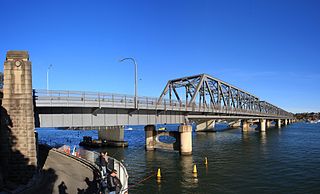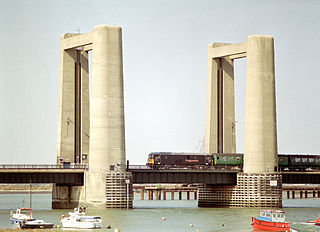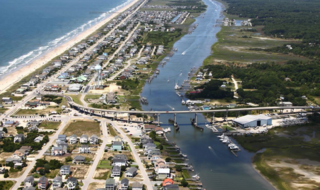
Mombasa is a coastal city in southeastern Kenya along the Indian Ocean. It was the first capital of British East Africa, before Nairobi was elevated to capital city status. It now serves as the capital of Mombasa County. The town is known as "the white and blue city" in Kenya. It is the country's oldest and second-largest city after the capital Nairobi, with a population of about 1,208,333 people according to the 2019 census. Its metropolitan region is the second-largest in the country, and has a population of 3,528,940 people.
Mombasa Island is a 5 by 3 km coral outcrop located on Kenya's coast on the Indian Ocean, which is connected to the mainland by a causeway. Part of the city of Mombasa is located on the island, including the Old Town.

The Ouse Bridge is a reinforced concrete plate girder bridge that spans River Ouse between Goole and Howden in the East Riding of Yorkshire, England. It carries the M62 and is situated between junctions 36 and 37. It was built between 1973 and 1976 by Costain and was designed by Scott Wilson Kirkpatrick & Partners. The bridge was officially opened to traffic on 24 May 1976 by nine-year-old Martin Brigham.

Bangabandhu Bridge, also known as the Jamuna Multi-purpose Bridge is a bridge opened in Bangladesh in June 1998. It connects Bhuapur on the Jamuna River's east bank to Sirajganj on its west bank. It was the 11th longest bridge in the world when constructed in 1998 and at present is the 6th longest bridge in South Asia. The Jamuna River, which it spans, is one of the three major rivers of Bangladesh, and is fifth largest in the world in discharge volume.

The Vashi Bridge, also known as Thane Creek Bridge or the Second Thane Creek Bridge, is a road bridge completed in the late 1990s across Thane Creek, which connects the city of Mumbai to the Indian mainland at Navi Mumbai. The bridge links the suburb of Mankhurd in Mumbai with Vashi in Navi Mumbai, the satellite city of Mumbai. It is one of four entry points into Mumbai, and handles traffic directed towards the region to the south and east of Mumbai.

The Nordhordland Bridge is a combined cable-stayed and pontoon bridge which crosses Salhusfjorden between Klauvaneset and the island of Flatøy in Vestland county, Norway. It is 1,614 meters (5,295 ft) long, of which the pontoon section is 1,246 meters (4,088 ft) long. The cable-stayed section consists of a single 99-meter (325 ft) tall H-pylon which has a length of 368 meters (1,207 ft) and a main span of 172 meters (564 ft). This allows for a clearance of 32 meters (105 ft).

Strelasund Crossing is the two links to the German island of Rügen (Rugia) over the Strelasund to the West Pomeranian mainland near Stralsund: the Rügen Bridge or Rugia Bridge and the Rugia Causeway.

The Bergsøysund Bridge is a pontoon bridge that crosses the Bergsøysundet strait between the islands of Aspøya and Bergsøya in Møre og Romsdal county, Norway. The bridge is 931 metres (3,054 ft) long, the longest span is 106 metres (348 ft), and the maximum clearance to the sea is 6 metres (20 ft). The bridge has 13 spans.

Tom Uglys Bridge are two road bridges, completed in 1929 and 1987, that carry the Princes Highway across the Georges River in southern Sydney, in the state of New South Wales, Australia. The bridges link the St George area at Blakehurst to the Sutherland Shire at Sylvania. Tom Uglys Bridge is one of six major road crossings of Georges River.

The Victoria Bridge (Penrith), also known as the Victoria Bridge over Nepean River and officially known as The Nepean Bridge, is a heritage-listed former railway bridge and now wrought iron box plate girder road bridge across the Nepean River on the Great Western Highway in the western Sydney suburb of Penrith in the City of Penrith local government area of New South Wales, Australia. The bridge was designed by John Whitton, the Engineer–in–Chief of New South Wales Government Railways, and built from 1862 to 1867 by William Piper, Peto Brassey and Betts (superstructure), William Watkins (piers). It is also known as Victoria Bridge, The Nepean Bridge and RTA Bridge No. 333. It was added to the New South Wales State Heritage Register on 27 May 2016.

The Kingsferry Bridge is a combined road and railway vertical-lift bridge which connects the Isle of Sheppey to mainland Kent in South East England. The seven-span bridge has a central lifting span which allows ships to pass.

The Incheon Bridge is a reinforced concrete cable-stayed bridge in South Korea. At its opening in October 2009, it became the second bridge connection between Yeongjong Island and the mainland of Incheon. The Incheon Bridge is South Korea's longest spanning cable-stayed bridge. In comparison, it is the world's tenth longest cable-stayed bridge as of January 2019.
The Makupa Causeway is a causeway linking Mombasa island to the Kenyan mainland. The road runs for approximately one and a half miles between the Magongo Circus and Makupa Circus. The causeway dissects Tudor Creek to the east and Port Reitz Creek to the west.

The Nyali Bridge was a floating pontoon bridge linking Mombasa Island to the Kenyan mainland.

The Godavari Arch Bridge is a bowstring-girder bridge that spans the Godavari River in Rajahmundry, India. It is the latest of the three bridges that span the Godavari river at Rajahmundry. The Havelock Bridge being the earliest, was built in 1897, and having served its full utility, was decommissioned in 1997. The second bridge known as the Godavari Bridge is a truss bridge and is India's third longest road-cum-rail bridge crossing a water body.

Nyali is a residential area and Sub-County within Mombasa City, located on the mainland north of Mombasa County. It is connected to Mombasa Island by the New Nyali Bridge. Nyali is known for its many high-class hotels and residential houses, modern standards, and long white sand beaches making it a popular destination for both local and foreign tourists.
Kilifi Bridge is the longest bridge in Kenya with a total length of 420 metres. The superstructure is a prestressed continuous box girder carrying two lanes. The bridge has three spans. The construction of Kilifi Bridge was completed in 1991.

The 65-foot-high (20 m) Holden Beach Bridge carries NC 130 across the Atlantic Intracoastal Waterway (ICW), connecting the town of Holden Beach to the mainland. The 1,800-foot-long (550 m) structure, built under contract to the North Carolina Department of Transportation, consists of 20 approach spans of Type III and IV prestressed concrete AASHTO girders and 3 channel spans of prestressed, precast box girders.

The Samuel De Champlain Bridge, colloquially known as the Champlain Bridge, is a cable-stayed bridge design by architect Poul Ove Jensen and built to replace the original Champlain Bridge over the Saint Lawrence River in Quebec, between Nuns' Island in the borough of Verdun in Montreal and the suburban city of Brossard on the South Shore. A second, connected bridge links Nuns' Island to the main Island of Montreal.

The Hay Bridge is a road bridge that carries the Cobb Highway across the Murrumbidgee River at Hay, New South Wales, Australia. The current bridge is the second bridge located in Hay that crosses the Murrumbidgee; the first bridge was in operation from 1873 until 1973; the second and current bridge has operated since 1973.


















